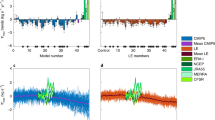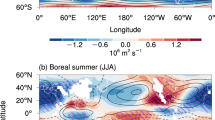Abstract
Predicting the response of tropical rainfall to climate change remains a challenge1. Rising concentrations of carbon dioxide are expected to affect the hydrological cycle through increases in global mean temperature and the water vapour content of the atmosphere2,3,4. However, regional precipitation changes also closely depend on the atmospheric circulation, which is expected to weaken in a warmer world4,5,6. Here, we assess the effect of a rise in atmospheric carbon dioxide concentrations on tropical circulation and precipitation by analysing results from a suite of simulations from multiple state-of-the-art climate models, and an operational numerical weather prediction model. In a scenario in which humans continue to use fossil fuels unabated, about half the tropical circulation change projected by the end of the twenty-first century, and consequently a large fraction of the regional precipitation change, is independent of global surface warming. Instead, these robust circulation and precipitation changes are a consequence of the weaker net radiative cooling of the atmosphere associated with higher atmospheric carbon dioxide levels, which affects the strength of atmospheric vertical motions. This implies that geo-engineering schemes aimed at reducing global warming without removing carbon dioxide from the atmosphere would fail to fully mitigate precipitation changes in the tropics. Strategies that may help constrain rainfall projections are suggested.
This is a preview of subscription content, access via your institution
Access options
Subscribe to this journal
Receive 12 print issues and online access
$259.00 per year
only $21.58 per issue
Buy this article
- Purchase on Springer Link
- Instant access to full article PDF
Prices may be subject to local taxes which are calculated during checkout




Similar content being viewed by others
References
Solomon, S. et al. in Climate Change 2007: The Physical Science Basis (eds Solomon, S. et al.) (Cambridge Univ. Press, 2007).
Mitchell, J. F. B. The seasonal response of a general circulation model to changes in CO2 and sea temperatures. Q. J. R. Meteorol. Soc. 109, 113–152 (1983).
Allen, M. R. & Ingram, W. J. Constraints on future changes in the hydrological cycle. Nature 419, 224–228 (2002).
Held, I. M. & Soden, B. J. Robust responses of the hydrological cycle to global warming. J. Clim. 19, 5686–5699 (2006).
Knutson, T. R. & Manabe, S. Time-mean response over the tropical Pacific to increased CO2 in a coupled ocean–atmosphere model. J. Clim. 8, 2181–2199 (1995).
Vecchi, G. A. & Soden, B. J. Global warming and the weakening of the tropical circulation. J. Clim. 20, 4316–4340 (2007).
Bony, S. et al. How well do we understand and evaluate climate change feedback processes? J. Clim. 19, 3445–3482 (2006).
Gregory, J. M. & Webb, M. J. Tropospheric adjustment induces a cloud component in CO2 forcing. J. Clim. 21, 58–71 (2008).
Taylor, K. E., Stouffer, R. J. & Meehl, G. A. An Overview of CMIP5 and the experiment design. Bull. Am. Meteorol. Soc. 93, 485–498 (2012).
Moss, R. et al. A new approach to scenario development for the IPCC Fifth Assessment Report. Nature 463, 747–756. (2010).
Emori, S. & Brown, S. J. Dynamic and thermodynamic changes in mean and extreme precipitation under changed climate. Geophys. Res. Lett. 32, L17706 (2005).
Chou, C., Neelin, J. D., Chen, C-A. & Tu, J-Y. Evaluating the ‘Rich-Get-Richer’ mechanism in tropical precipitation change under global warming. J. Clim. 22, 1982–2005 (2009).
Seager, R., Naik, N. & Vecchi, G. A. Thermodynamic and dynamic mechanisms for large-scale changes in the hydrological cycle in response to global warming. J. Clim. 23, 4651–4668 (2010).
Muller, C. J. & O’Gorman, P. A. An energetic perspective on the regional response of precipitation to climate change. Nature Clim. Change 1, 266–271 (2011).
Liu, C., Allan, R. P. & Huffman, G. J. Co-variation of temperature and precipitation in CMIP5 models and satellite observations. Geophys. Res. Lett. 39, L13803 (2012).
Chou, C. et al. Increase in the range between wet and dry season precipitation. Nature Geosci. 6, 263–267 (2013).
Joshi, M., Gregory, J., Webb, M., Sexton, D. & Johns, T. Mechanisms for the land-sea warming contrast exhibited by simulations of climate change. Clim. Dynam. 30, 455–465 (2008).
Cao, L., Bala, G. & Caldeira, K. Climate response to changes in atmospheric carbon dioxide and solar irradiance on the timescale of days to weeks. Environ. Res. Lett. 7, 034015 (2012).
Sobel, A. H. & Bretherton, C. S. Modelling tropical precipitation in a single column. J. Clim. 13, 4378–4392 (2000).
Phillips, T. J. et al. Evaluating parameterizations in general circulation models: Climate simulation meets weather prediction. Bull. Am. Meteorol. Soc. 85, 1903–1915 (2004).
Bechtold, P. et al. Advances in simulating atmospheric variability with the ECMWF model: From synoptic to decadal timescales. Q. J. R Meteorol. Soc. 134, 1337–1351 (2008).
Wyant, M. C., Bretherton, C. S., Blossey, P. N. & Khairoutdinov, M. Fast cloud adjustment to increasing CO2 in a superparameterized climate model. JAMES 4, M05001 (2012).
Bala, G., Duffy, P. B. & Taylor, K. E. Impact of geoengineering schemes on the global hydrological cycle. Proc. Natl Acad. Sci. USA 105, 7664–7669 (2008).
Schmidt, H. et al. Solar irradiance reduction to counteract radiative forcing from a quadrupling of CO2: Climate responses simulated by four Earth System Models. Earth Syst. Dynam. 3, 63–78 (2012).
Andrews, T., Gregory, J., Webb, M. & Taylor, K. Forcing, feedbacks and climate sensitivity in CMIP5 coupled atmosphere-ocean climate models. Geophys. Res. Lett. 39, L09712 (2012).
Rodwell, M. & Palmer, T. N. Using numerical weather prediction to assess climate models. Q. J. R. Meteorol. Soc. 133, 129–146 (2009).
Neelin, J. D. in The Global Circulation of the Atmosphere (eds Schneider, T. & Sobel, A.) 267–301 (Princeton Univ. Press, 2007).
Hourdin, F. et al. The LMDZ general circulation model: Climate performance and sensitivity to parameterized physics with emphasis on tropical convection. Clim. Dynam. 19, 3445–3482 (2006).
Dufresne, J-L. et al. Climate change projections using the IPSL-CM5 Earth System Model: From CMIP3 to CMIP5. Clim. Dynam.http://dx.doi.org/10.1007/s00382-012-1636-1 (2013).
Raymond, D. J. & Zeng, X. Modelling tropical atmospheric convection in the context of the weak temperature gradient approximation. Q. J. R. Meteorol. Soc. 131, 1301–1320 (2005).
Acknowledgements
This work benefited from discussions with K. Emanuel, J-L. Dufresne, B. Stevens and T. Palmer, and from the technical help of J. Raciasek. The research leading to these results has received funding from the European Union, Seventh Framework Programme (FP7/2007-2013) under grant agreement no. 244067(EUCLIPSE), the French CEP&S 2010 ANR project ClimaConf and the LEFE project Missterre. We acknowledge the World Climate Research Programme’s Working Group on Coupled Modelling, which is responsible for CMIP, and we thank the climate modelling groups (listed in the Supplementary Information) for producing and making available their model output. For CMIP the US Department of Energy’s Program for Climate Model Diagnosis and Intercomparison provides coordinating support and led development of software infrastructure in partnership with the Global Organisation for Earth System Science Portals.
Author information
Authors and Affiliations
Contributions
S.B. designed the study and performed the analysis. S.B. and S.S. wrote the paper. D.K. designed and performed ECMWF forecasts and contributed to the graphics. G.B. designed and performed single-column simulations, S.F. designed and performed short-term IPSL simulations, S.D. organized the retrieval of CMIP5 model outputs. All authors discussed the results and edited the manuscript.
Corresponding author
Ethics declarations
Competing interests
The authors declare no competing financial interests.
Supplementary information
Supplementary Information
Supplementary Information (PDF 6018 kb)
Rights and permissions
About this article
Cite this article
Bony, S., Bellon, G., Klocke, D. et al. Robust direct effect of carbon dioxide on tropical circulation and regional precipitation. Nature Geosci 6, 447–451 (2013). https://doi.org/10.1038/ngeo1799
Received:
Accepted:
Published:
Issue Date:
DOI: https://doi.org/10.1038/ngeo1799
This article is cited by
-
Significantly wetter or drier future conditions for one to two thirds of the world’s population
Nature Communications (2024)
-
Robust changes in global subtropical circulation under greenhouse warming
Nature Communications (2024)
-
The weakening of the tropical circulation is caused by the lifting of the tropopause height
Climate Dynamics (2024)
-
Increase in ocean-onto-land droughts and their drivers under anthropogenic climate change
npj Climate and Atmospheric Science (2023)
-
Human-induced weakening of the Northern Hemisphere tropical circulation
Nature (2023)



